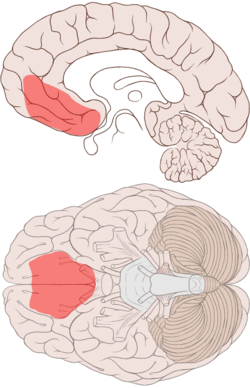

| Ventromedial prefrontal cortex | |
|---|---|

Ventromedial prefrontal cortex shown on medial and ventral views of the brain, reflecting approximate location of damage in patients with decision making deficits.[1].
| |

Medial surface of the brain with Brodmann's areas numbered.
| |
| Anatomical terms of neuroanatomy |
The ventromedial prefrontal cortex is a part of the prefrontal cortex in the mammalian brain. The ventral medial prefrontal is located in the frontal lobe and is implicated in the processing of risk, fear, and in decision making.
The ventromedial prefrontal cortex has been described as equivalent to Brodmann area 10.[2] However, not all sources agree on the boundaries of the area.
To get a rough idea of where the ventromedial prefrontal cortex is, recall that the left and right hemispheres of the brain are separated (by the longitudinal cerebral fissure.) Now imagine you could take your hand and starting at the anterior brain (where your forehead is) insert it into this gap until you reached the insula (a structure that is beneath the frontal lobe.) Your palm would be touching a part of the prefrontal cortex, which is in the front part of the brain and the lower part of your palm would be touching the ventral medial prefrontal cortex.
Note that different researchers use the term 'Ventromedial prefrontal cortex' differently. Sometimes, the term is saved for the area above the medial orbitofrontal cortex, while at other times, 'ventromedial prefrontal cortex' is used to describe a broad area in the lower (ventral) central (medial) region of the prefrontal cortex, of which the medial orbitofrontal cortex constitutes the lower-most part. This latter, broader area corresponds to the area damaged in patients with decision-making impairments investigated by António Damásio and colleagues (see diagram, and below).
As of yet, functional differences between the orbitofrontal and ventromedial areas of the pre-frontal cortex are not clearly established, although the areas of the ventromedial cortex superior to the orbitofrontal cortex are much less associated with social functions and more with pure emotion regulation. Research in developmental neuroscience also suggested that neural networks in the ventromedial prefrontal cortex are rapidly developing during adolescence and young adulthood supporting emotion regulation through the amygdala[3], being associated with a decrease in cortisol levels.
Left lateral and medial orbitofrontal cortex areas were also measured to be highly active during guessing tasks. An increase in probabilistic scenario complexity was associated with orbitofrontal cortex activity level increase, therefore suggesting the special role that the ventromedial prefrontal cortex plays in decision making containing uncertainty. A study also indicated that patients with lesions in the ventromedial prefrontal cortex tend to have difficulties reacting to future consequences.
The right half of the ventromedial prefrontal cortex was associated with regulating the interaction of cognition and affect in the production of empathic responses. Hedonic (pleasure) responses were also associations to orbitofrontal cortex activity level by Morten Kringelbach. This finding contributes findings suggesting ventromedial prefrontal cortex being associated with preference judgement, possibly assigning the ventromedial prefrontal cortex a key role in constructing one's self. Studies with PTSD also supported the idea that the ventromedial prefrontal cortex is an important component for reactivating past emotional associations and events, therefore essentially mediating pathogenesis of PTSD. Treatments geared to the inhibition of the ventromedial prefrontal cortex were therefore suggested for PTSD. The right half of the ventrolateral prefrontal cortex, being active during emotion regulation, was activated when participants were offered an unfair offer in a scenario. Specific deficits in reversal learning and decision-making have led to the hypothesis advanced by Shibley Rahman that the ventromedial prefrontal cortex is a major locus of dysfunction in the mild stages of the behavioural variant of frontotemporal dementia.
One particularly notable theory of VMPFC function is the somatic marker hypothesis, accredited to António Damásio. By this hypothesis, the VMPFC has a central role in adapting somatic markers - emotional associations, or associations between mental objects and visceral (bodily) feedback - for use in natural decision making. This account also gives the VMPFC a role in moderating emotions and emotional reactions.
Ventromedial prefrontal cortex lesions were also associated with a deficit in processing gender specific social cues.
{{cite journal}}: Unknown parameter |month= ignored (help)CS1 maint: multiple names: authors list (link)
{{cite journal}}: Explicit use of et al. in: |author= (help); Unknown parameter |month= ignored (help)CS1 maint: multiple names: authors list (link)
{{cite journal}}: Unknown parameter |coauthor= ignored (|author= suggested) (help)
{{cite journal}}: Unknown parameter |month= ignored (help)CS1 maint: multiple names: authors list (link){{cite journal}}: Unknown parameter |month= ignored (help)CS1 maint: multiple names: authors list (link){{cite journal}}: Unknown parameter |month= ignored (help)CS1 maint: multiple names: authors list (link){{cite journal}}: Unknown parameter |month= ignored (help)CS1 maint: multiple names: authors list (link)Intensity to Future Consequences Following Damage to Human Prefrontal Cortex
{{cite journal}}: Explicit use of et al. in: |author= (help); Unknown parameter |month= ignored (help)CS1 maint: multiple names: authors list (link){{cite journal}}: Unknown parameter |month= ignored (help){{cite journal}}: Unknown parameter |month= ignored (help)CS1 maint: multiple names: authors list (link){{cite journal}}: Unknown parameter |month= ignored (help)CS1 maint: multiple names: authors list (link){{cite journal}}: Unknown parameter |month= ignored (help){{cite journal}}: Explicit use of et al. in: |author= (help); Unknown parameter |month= ignored (help)CS1 maint: multiple names: authors list (link)This neuroanatomy article is a stub. You can help Wikipedia by expanding it. |
|
Anatomy of the cerebral cortex of the human brain
| |||||||||||||||
|---|---|---|---|---|---|---|---|---|---|---|---|---|---|---|---|
| Frontal lobe |
| ||||||||||||||
| Parietal lobe |
| ||||||||||||||
| Occipital lobe |
| ||||||||||||||
| Temporal lobe |
| ||||||||||||||
| Interlobar sulci/fissures |
| ||||||||||||||
| Limbic lobe |
| ||||||||||||||
| Insular cortex |
| ||||||||||||||
| General |
| ||||||||||||||
Some categorizations are approximations, and some Brodmann areas span gyri. | |||||||||||||||